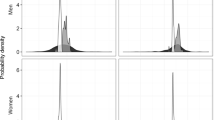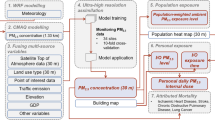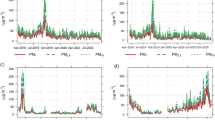Abstract
Many studies have focused on the relationships of particulate matter between indoor, outdoor and personal exposure; however, considerable uncertainties remain regarding the portion of indoor particles and personal exposure of ambient origin. As part of the Particle Exposure Assessment for Community Elderly (PEACE) study in Tianjin, China, we have further interpreted the relationships between personal, residential indoor, outdoor and community PM10 (particulate matter with aerodynamic diameters of less than 10 μm). Comparisons of the chemical compositions of PM10 samples were performed using the coefficient of divergence (COD). A robust regression method, least-trimmed squared (LTS) regression, was used to estimate the infiltration factors of PM10 from residential outdoor to indoor environments based on the particulate component concentrations. Personal exposures of ambient origin were also estimated. A relatively good correlation was found between the personal and indoor PM10 samples with respect to chemical composition. The infiltration factors (Finf) of the residential indoor–outdoor PM10 were 0.74±0.31 (mean±SD) in summer and 0.44±0.22 in winter, with medians of 0.98 and 0.48, respectively. The residential outdoor contributions to the indoor environments were 87±55 μg/m3 in summer and 80±54 μg/m3 in winter, with medians of 75 μg/m3 and 61 μg/m3, respectively. The personal exposures of ambient origin were 92±44 μg/m3 in summer and 89±47 μg/m3 in winter, with medians of 81 μg/m3 and 80 μg/m3, respectively. This study indicated that the infiltrations in an urbanized area in North China exhibited a seasonal difference: the residential outdoor contributions to residential indoor environments were larger in summer due to the higher use of natural ventilation. The personal exposures of ambient origin were comparable during the different seasons, whereas those of non-ambient origin were higher in summer than in winter.
This is a preview of subscription content, access via your institution
Access options
Subscribe to this journal
Receive 6 print issues and online access
$259.00 per year
only $43.17 per issue
Buy this article
- Purchase on Springer Link
- Instant access to full article PDF
Prices may be subject to local taxes which are calculated during checkout


Similar content being viewed by others
References
Pope CA, 3rd, Burnett RT, Thun MJ, Calle EE, Krewski D, Ito K et al. Lung cancer, cardiopulmonary mortality, and long-term exposure to fine particulate air pollution. JAMA 2002; 287: 1132–1141.
Lim SS, Vos T, Flaxman AD, Danaei G, Shibuya K, Adair-Rohani H et al. A comparative risk assessment of burden of disease and injury attributable to 67 risk factors and risk factor clusters in 21 regions, 1990-2010: a systematic analysis for the Global Burden of Disease Study 2010. Lancet 2012; 380: 2224–2260.
Zhang L-W, Chen X, Xue X-D, Sun M, Han B, Li C-P et al. Long-term exposure to high particulate matter pollution and cardiovascular mortality: A 12-year cohort study in four cities in northern China. Environ Int 2014; 62: 41–47.
Meng X, Wang CC, Cao DC, Wong CM, Kan HD . Short-term effect of ambient air pollution on COPD mortality in four Chinese cities. Atmos Environ 2013; 77: 149–154.
Meng QY, Turpin BJ, Korn L, Weisel CP, Morandi M, Colome S et al. Influence of ambient (outdoor) sources on residential indoor and personal PM2.5 concentrations: analyses of RIOPA data. J Expo Anal Environ Epidemiol 2005; 15: 17–28.
Mage D, Wilson W, Hasselblad V, Grant L . Assessment of human exposure to ambient particulate matter. J Air Waste Manag Assoc 1999; 49: 1280–1291.
Zhou B, Zhao B, Guo X, Chen R, Kan H . Investigating the geographical heterogeneity in PM10-mortality associations in the China Air Pollution and Health Effects Study (CAPES): a potential role of indoor exposure to PM10 of outdoor origin. Atmos Environ 2013; 75: 217–223.
Chen R, Zhou B, Kan H, Zhao B . Associations of particulate air pollution and daily mortality in 16 Chinese cities: an improved effect estimate after accounting for the indoor exposure to particles of outdoor origin. Environ Pollut 2013; 182: 278–282.
Chen C, Zhao B, Weschler CJ . Indoor exposure to "Outdoor PM10" assessing its influence on the relationship between PM10 and short-term mortality in US cities. Epidemiology 2012; 23: 870–878.
Zhou J, Han B, Bai Z, You Y, Zhang J, Niu C et al. Particle exposure assessment for community elderly (PEACE) in Tianjin, China: mass concentration relationships. Atmos Environ 2012; 49: 77–84.
Williams R, Suggs J, Creason J, Rodes C, Lawless P, Kwok R et al. The 1998 Baltimore particulate matter Epidemiology-Exposure Study: Part 2. Personal exposure assessment associated with an elderly study population. J Expos Anal Environ Epidemiol 2000; 10: 533–543.
Rodes CE, Lawless PA, Evans GF, Sheldon LS, Williams RW, Vette AF et al. The relationships between personal PM exposures for elderly populations and indoor and outdoor concentrations for three retirement center scenarios. J Expos Anal Environ Epidemiol 2001; 11: 103–115.
MacNeill M, Wallace L, Kearney J, Allen RW, Van Ryswyk K, Judek S et al. Factors influencing variability in the infiltration of PM2.5 mass and its components. Atmos Environ 2012; 61: 518–532.
Abt E, Suh HH, Allen G, Koutrakis P . Characterization of indoor particle sources: a study conducted in the metropolitan Boston area. Environ Health Perspect 2000; 108: 35–44.
Abt E, Suh HH, Catalano P, Koutrakis P . Relative contribution of outdoor and indoor particle sources to indoor concentrations. Environ Sci Technol 2000; 34: 3579–3587.
Hoek G, Kos G, Harrison RM, de Hartog J, Meliefste K, ten Brink H et al. Indoor-outdoor relationships of particle number and mass in four European cities. Atmos Environ 2008; 42: 156–169.
Chen C, Zhao B . Review of relationship between indoor and outdoor particles: I/O ratio, infiltration factor and penetration factor. Atmos Environ 2011; 45: 275–288.
Meng QY, Turpin BJ, Polidori A, Lee JH, Weisel C, Morandi M et al. PM2.5 of ambient origin: estimates and exposure errors relevant to PM epidemiology. Environ Sci Technol 2005; 39: 5105–5112.
Dimitroulopoulou C, Ashmore MR, Hill MTR, Byrne MA, Kinnersley R . INDAIR: a probabilistic model of indoor air pollution in UK homes. Atmos Environ 2006; 40: 6362–6379.
Wallace LA, Mitchell H, O’Connor GT, Neas L, Lippmann M, Kattan M et al. Particle concentrations in inner-city homes of children with asthma: The effect of smoking, cooking, and outdoor pollution. Environ Health Perspect 2003; 111: 1265–1272.
Williams R, Suggs J, Rea A, Leovic K, Vette A, Croghan C et al. The Research Triangle Park particulate matter panel study: PM mass concentration relationships. Atmos Environ 2003; 37: 5349–5363.
Williams R, Suggs J, Rea A, Sheldon L, Rodes C, Thornburg J . The Research Triangle Park particulate matter panel study: modeling ambient source contribution to personal and residential PM mass concentrations. Atmos Environ 2003; 37: 5365–5378.
Chao CYH, Tung TC . An empirical model for outdoor contaminant transmission into residential buildings and experimental verification. Atmos Environ 2001; 35: 1585–1596.
Cao JJ, Lee SC, Chow JC, Cheng Y, Ho KF, Fung K et al. Indoor/outdoor relationships for PM2.5 and associated carbonaceous pollutants at residential homes in Hong Kong - case study. Indoor Air 2005; 15: 197–204.
Baumgartner J, Schauer JJ, Ezzati M, Lu L, Cheng C, Patz J et al. Patterns and predictors of personal exposure to indoor air pollution from biomass combustion among women and children in rural China. Indoor Air 2011; 21: 479–488.
GB 3095-1996 China National Ambient Air Quality Standard. In: Ministry of Environmental Protection of the People's Republic of China..
The 2012 Report on the State of the Environment in China (in Chinese). Available on line http://jcs.mep.gov.cn/hjzl/zkgb/2012zkgb/201306/t20130606_253402.htm Ministry of Environmental Protection of China, 2013.
Kong SF, Lu B, Bai ZP, Zhao XY, Chen L, Han B et al. Potential threat of heavy metals in re-suspended dusts on building surfaces in oilfield city. Atmos Environ 2011; 45: 4192–4204.
Chow JC, Watson JG, Chen LWA, Chang MCO, Robinson NF, Trimble D et al. The IMPROVE-A temperature protocol for thermal/optical carbon analysis: maintaining consistency with a long-term database. JAir Waste Manag Assoc 2007; 57: 1014–1023.
Wang Y, Zhuang GS, Tang AH, Yuan H, Sun YL, Chen SA et al. The ion chemistry and the source of PM2.5 aerosol in Beijing. Atmos Environ 2005; 39: 3771–3784.
Gu J, Schnelle-Kreis J, Pitz M, Diemer J, Reller A, Zimmermann R et al. Spatial and temporal variability of PM10 sources in Augsburg, Germany. Atmos Environ 2013; 71: 131–139.
Wilson JG, Kingham S, Pearce J, Sturman AP . A review of intraurban variations in particulate air pollution: implications for epidemiological research. Atmos Environ 2005; 39: 6444–6462.
Wongphatarakul V, Friedlander SK, Pinto JP . A comparative study of PM2.5 ambient aerosol chemical databases. Environ Sci Technol 1998; 32: 3926–3934.
Ott W, Wallace L, Mage D . Predicting particulate (PM10) personal exposure distributions using a random component superposition statistical model. J Air Waste Manag Assoc 2000; 50: 1390–1406.
Rodes CE, Lawless PA, Thornburg JW, Williams RW, Croghan CW . DEARS particulate matter relationships for personal, indoor, outdoor, and central site settings for a general population. Atmos Environ 2010; 44: 1386–1399.
Pekey B, Bozkurt ZB, Pekey H, Dogan G, Zararsiz A, Efe N et al. Indoor/outdoor concentrations and elemental composition of PM10/PM2.5 in urban/industrial areas of Kocaeli City, Turkey. Indoor Air 2010; 20: 112–125.
Lazaridis M, Aleksandropoulou V, Smolik J, Hansen JE, Glytsos T, Kalogerakis N et al. Physico-chemical characterization of indoor/outdoor particulate matter in two residential houses in Oslo, Norway: measurements overview and physical properties - URBAN-AEROSOL Project. Indoor Air 2006; 16: 282–295.
Jo W-K, Lee J-Y . Indoor and outdoor levels of respirable particulates (PM10) and Carbon Monoxide (CO) in high-rise apartment buildings. Atmos Environ 2006; 40: 6067–6076.
Monn C, Fuches A, Hogger D, Junker M, Kogelschatz D, Roth N et al. Particulate matter less than 10 mum (PM10) and fine particles less than 2.5 mum (PM2.5): relationships between indoor, outdoor and personal concentrations. Sci Total Environ 1997; 208: 15–21.
Zhu C-S, Cao J-J, Tsai C-J, Shen Z-X, Ho K-F, Liu S-X . The indoor and outdoor carbonaceous pollution during winter and summer in rural areas of Shaanxi, China. Aerosol Air Qual Res 2010; 10: 550–558.
Meng QY, Turpin BJ, Lee JH, Polidori A, Weisel CP, Morandi M et al. How does infiltration behavior modify the composition of ambient PM2.5 in indoor spaces? An analysis of RIOPA data. Environ Sci Technol 2007; 41: 7315–7321.
Fromme H, Diemer J, Dietrich S, Cyrys J, Heinrich J, Lang W et al. Chemical and morphological properties of particulate matter (PM10, PM2.5) in school classrooms and outdoor air. Atmos Environ 2008; 42: 6597–6605.
Pellizzari ED, Clayton CA, Rodes CE, Mason RE, Piper LL, Fort B et al. Particulate matter and manganese exposures in Indianapolis, Indiana. J Expos Anal Environ Epidemiol 2001; 11: 423–440.
Gemenetzis P, Moussas P, Arditsoglou A, Samara C . Mass concentration and elemental composition of indoor PM2.5 and PM10 in university rooms in Thessaloniki, northern Greece. Atmos Environ 2006; 40: 3195–3206.
Slezakova K, Pereira MC, Alvim-Ferraz MC . Influence of tobacco smoke on the elemental composition of indoor particles of different sizes. Atmos Environ 2009; 43: 486–493.
Ward T, Noonan C . Results of a residential indoor PM(2.5) sampling program before and after a woodstove changeout. Indoor Air 2008; 18: 408–415.
Hsu SI, Ito K, Kendall M, Lippmann M . Factors affecting personal exposure to thoracic and fine particles and their components. J Expos Sci Environ Epidemiol 2012; 22: 439–447.
Acknowledgements
This study was funded by the “National Basic Research Program of China” (Grants No. 2011CB503801).
Author information
Authors and Affiliations
Corresponding author
Ethics declarations
Competing interests
The authors declare no conflict of interest.
Additional information
Supplementary Information accompanies the paper on the Journal of Exposure Science and Environmental Epidemiology website
Supplementary information
Rights and permissions
About this article
Cite this article
Xu, J., Bai, Z., You, Y. et al. Residential indoor and personal PM10 exposures of ambient origin based on chemical components. J Expo Sci Environ Epidemiol 24, 428–436 (2014). https://doi.org/10.1038/jes.2014.28
Received:
Revised:
Accepted:
Published:
Issue Date:
DOI: https://doi.org/10.1038/jes.2014.28



